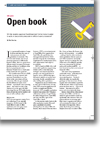
Open book
- Article 1 of 3
- IK Magazine, July 2006
Will the recently approved OpenDocument Format make it easier to work on documents produced on different word processors?
Open source and open standards have been beating Microsoft on many fronts of late. Linux is a serious threat to Microsoft on the server and other applications are making inroads against Microsoft’s dominance elsewhere. But can the OpenDocument Format (ODF) threaten Redmond?
Originally designed as the file format of the OpenOffice 2.0 suite of applications, ODF is an open document standard, approved by Oasis and the ISO. ODF is XML-based with a well-documented API that supports various data types that make it suitable for word processing, spreadsheet and other desktop office applications. Programmers can use standard tools to write a file in the ODF format, and any other ODF-compatible application will be able to understand and load that document. ODF-compatible applications include IBM Workplace, Google Writely, OpenOffice and Sun’s StarOffice
Microsoft has gained significant advantage in the productivity tools market through its various Office file formats, which include Word and Excel files. These are binary file formats that are not well documented, making it hard for other vendors to create applications that can open and save Office documents successfully. Anyone wanting to exchange files with Office users successfully has typically had to use intermediate file formats or to buy their own version of Office.
This causes many organisations considerable worry. They are concerned that they will be not be able to open their documents in future as well as current applications. Indeed, Microsoft has often released versions of its Office suite that are unable to open documents created by significantly older versions of the suite.
This is why ODF is starting to look appealing. Says Forrester Research analyst Kyle McNabb, “Because of its adoption as an industry standard, organisations can use [ODF] to address document longevity requirements, a benefit that appeals to many public sector organisations concerned with managing and retaining public records.” Organisations that now use ODF to ensure the longevity of their archives include Singapore’s Ministry of Defence, France’s Ministry of Finance and the cities of Munich and Vienna.
Compatibility with existing users is also a problem. Many organisations hold off from purchasing Microsoft Office for all their users because of the licensing costs. Says Gartner Research analyst Rita Knox, “Government agencies worldwide are increasingly seeking document format compatibility among users who don’t have access to common applications, particularly Microsoft Office.”
ODF’s threat to Microsoft should therefore be clear: if organisations switch to using ODF as their standard file format, they will be free to pick whichever productivity suite they like, rather than have to buy Office by default. This will cut into Office’s market share and affects Microsoft’s profits.
Microsoft has fought back against this threat, proclaiming the virtues of Office file formats over ODF, arguing that Office’s file formats offer greater performance than ODF. “The use of OpenDocument documents is slower to the point of not really being satisfactory,” says Alan Yates, the general manager of Microsoft’s information worker strategy. Microsoft also argues that ODF has gaps in its API that make it impossible for vendors to offer the same level of functionality as with its formats without adding their own standards.
The problems facing Microsoft were made ever clearer by recent events in Massachusetts. The state government of Massachusetts decided late last year to mandate the use of ODF in all its executive offices by 2007. Microsoft petitioned Massachusetts against this, going to the length of offering an ODF importer and exporter for its own suite to calm any fears of vendor lock-in.
Yet, if Office users are able to save to ODF, how does Microsoft expect to lock users into its suite? Can ODF be as much of a threat as it might seem at first if Microsoft is willing to make this compromise?
The issue becomes even less clear-cut with the latest version of Office, which deploys Microsoft’s new XML-based Office file formats, “Open XML”. These too have published definitions and have been entrusted to another standards body, the European Computer Manufacturers’ Association (ECMA); Microsoft has also submitted Open XML to ISO, although ISO is unlikely to approve a second XML document standard.
Gartner’s Knox also argues that closed file formats are no longer a good way to lock in users, particularly with the advent on online productivity applications, such as OfficeLive. “Standardised formats will make it easier to integrate Office data into other applications, and to build new products that use these formats. This is primarily in Microsoft’s self-interest – to avoid further user enmity. File compatibility is rapidly becoming an ineffective way to protect market share. Microsoft’s strategy is to embed Microsoft Office features and functionality into customers’ business processes by integrating desirable product ‘elements’ with other applications and applets. Microsoft does not need to control the file specification to achieve this, therefore changing the competitive landscape for office productivity suites.”
ODF’s chances of affecting the enterprise are quite small. With Microsoft owning 95% of the productivity suite market, according to Gartner, and that position unlikely to change over the next few years, Office documents will continue to be the standard in most organisations. Organisations making the switch away from Microsoft Office are more likely to use ODF, but exchange of documents with other organisations will require the use of intermediate formats, most likely PDF but more likely Office formats when editability is required. The adoption by organisations of Open XML for documents will slow adoption of ODF, since future-proofing will be far less of a concern. And online services will make file format far less important.
Perhaps the only real hope for serious adoption of ODF is a merger of the standard with Open XML. But whether such a merger would happen on Microsoft’s terms or on the ODF Alliance’s terms remains to be seen – the money is on Microsoft to win, as usual.

